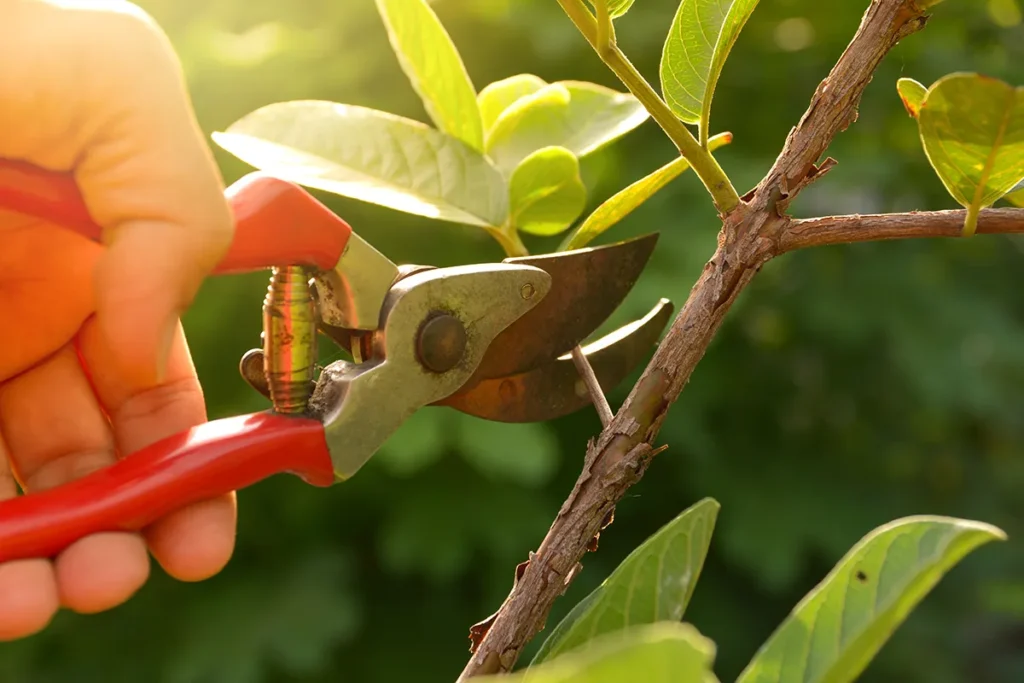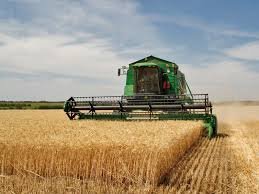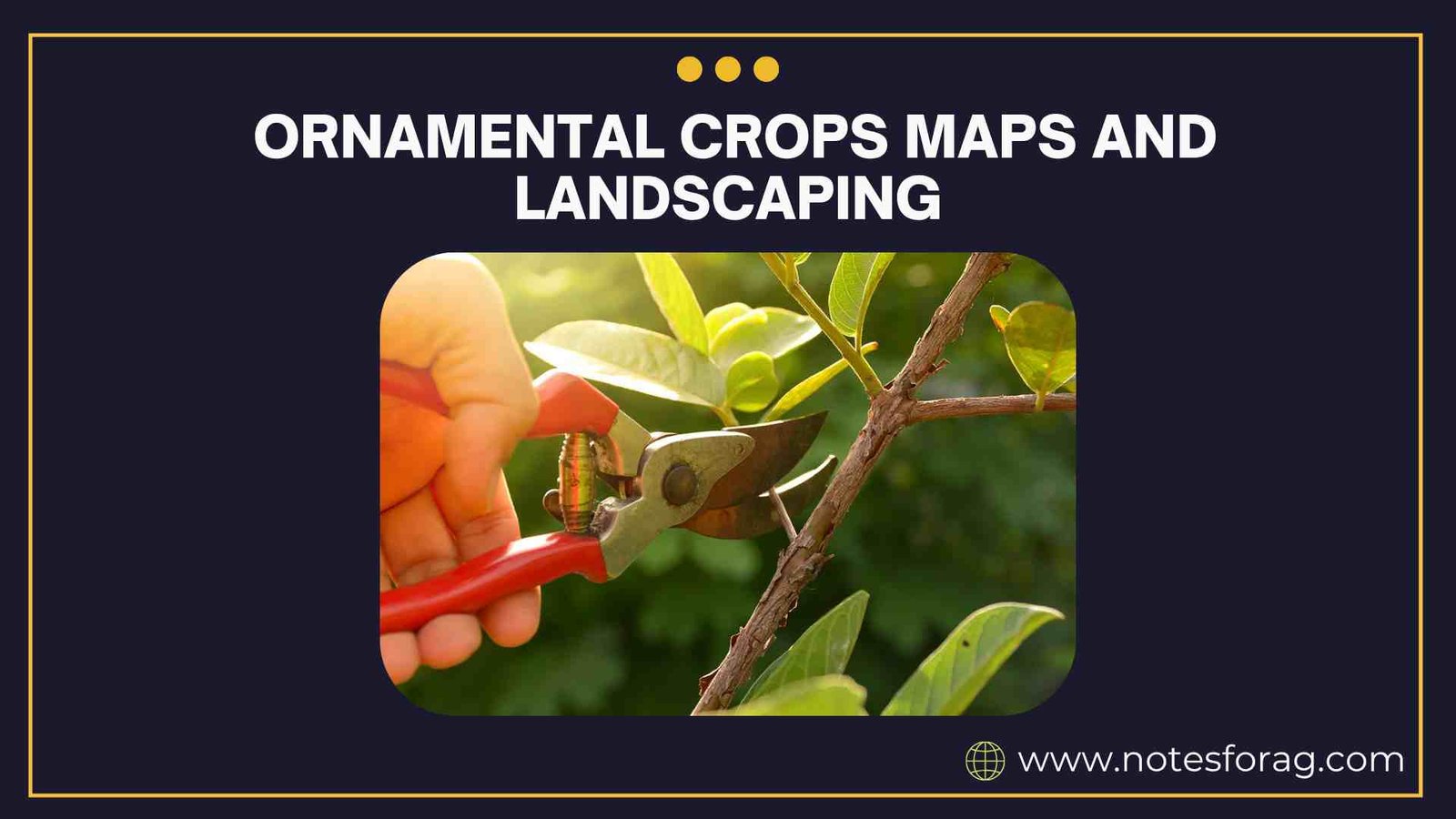INTRODUCTION
Ornamental horticulture plays a vital role in beautifying spaces, enhancing mental well-being, and adding economic value through commercial floriculture and landscaping. The production technology for ornamental crops focuses on scientifically managing plant selection, propagation, cultivation, and maintenance to achieve high-quality output suitable for aesthetic and functional purposes. Landscaping, along with proper mapping and design planning, helps create environmentally harmonious and visually pleasing outdoor environments.
Summary of ornamental crops maps and landscaping
- Ornamental crops and landscapes enhance both beauty and wellness by purifying air, reducing heat, and creating stress‑relieving green spaces in homes and cities .
- Modern production practices from seedling nurseries and tissue culture to precision irrigation, nutrient management, and pest control ensure superior plant quality and uniform flowering .
- Thoughtful mapping and design using formal, informal, and theme gardens, combined with design principles like scale, color, and texture, help create functional, aesthetic, and sustainable outdoor spaces .
Table of Contents
IMPORTANCE OF ORNAMENTAL CROPS AND LANDSCAPING
Aesthetic and Environmental Benefits
Ornamental plants add visual appeal to homes, parks, offices, and public spaces. Beyond beauty, they contribute to environmental health by purifying the air, reducing noise pollution, conserving soil, and lowering urban temperatures through evapotranspiration.
Economic Value
The ornamental plant industry generates income through the sale of flowers, foliage plants, landscaping services, and decorative accessories. It supports nurseries, retail stores, garden centers, and landscape designers.
Social and Psychological Impact
Gardens, floral arrangements, and green spaces have been linked to stress reduction, enhanced creativity, social cohesion, and improved mental health, making them valuable components of urban planning and community spaces.
CLASSIFICATION OF ORNAMENTAL CROPS
Based on Use
- Flowering Annuals: Marigold, Petunia, Zinnia
- Foliage Plants: Croton, Ferns, Philodendron
- Bulbous Plants: Gladiolus, Lily, Tulip
- Creepers and Climbers: Bougainvillea, Money plant
- Shrubs and Hedges: Hibiscus, Duranta
- Trees: Gulmohar, Jacaranda, Bottlebrush
Based on Growing Conditions
- Indoor Plants: Peace lily, Snake plant, Spider plant
- Outdoor Plants: Rose, Sunflower, Hibiscus
- Shade-Loving Plants: Caladium, Ferns
- Sun-Loving Plants: Gerbera, Marigold
PROPAGATION OF ORNAMENTAL CROPS
Sexual Propagation

Seeds are used for crops like Petunia, Marigold, and Zinnia. Proper seed treatment, sowing depth, spacing, and nursery care are crucial to ensure uniform germination and strong seedlings.
Asexual Propagation
- Cuttings: Rose, Hibiscus, Bougainvillea
- Layering: Jasmine, Bougainvillea
- Grafting and Budding: Roses, Camellias
- Division and Suckers: Chrysanthemum, Banana
- Tissue Culture: Orchids, Anthurium, Gerbera
NURSERY MANAGEMENT FOR ORNAMENTALS
Site Selection and Layout
The nursery should be well-drained, sunny, and close to water sources and markets. It must include seedbeds, mist chambers, propagation structures, and mother stock areas.
Soil and Media Preparation
The soil must be rich in organic matter and free from pests. Common potting mixes include garden soil, FYM, sand, and cocopeat. Proper sterilization is necessary to avoid diseases.
Irrigation and Fertilization
Drip or sprinkler systems are ideal for ornamental nurseries. Balanced fertilizers (NPK), slow-release formulations, and micronutrients support lush, healthy growth.
Pest and Disease Management
Integrated Pest Management (IPM) methods involving physical, cultural, and biological controls are recommended. Fungicides and insecticides should be used carefully.
CULTIVATION PRACTICES
Land Preparation
The land should be plowed thoroughly and enriched with organic manure. Raised beds or flatbeds are chosen based on the crop and local conditions.
Planting Techniques
Transplanting of seedlings or direct planting of cuttings depends on species. Proper spacing is vital for air circulation and optimal sunlight.
Irrigation Scheduling
Most ornamental crops require regular watering, especially during the establishment phase. Watering frequency depends on season, plant age, and soil moisture retention.
Weeding and Mulching
Regular weeding improves plant health and appearance. Organic mulches like straw or bark conserve moisture, suppress weeds, and enhance aesthetics.
PRUNING, TRAINING, AND PINCHING
Pruning

Removes dead, diseased, or unwanted branches to improve shape, health, and flowering.
Training
Used for climbing plants like Bougainvillea to shape and guide their growth using supports or trellises.
Pinching
Involves removing the apical bud to encourage lateral branching, resulting in bushier plants and more blooms.
HARVESTING AND POST-HARVEST HANDLING

Harvesting Stage
Flowers should be harvested at the right stage to ensure long shelf life and appearance. For example, Gerbera is cut when the outer ring of disc florets opens.
Handling and Packaging
Flowers are sorted, graded, and packed in boxes with protective liners. Cold storage is used to retain freshness, and preservatives may be added to prolong vase life.
LANDSCAPING PRINCIPLES AND DESIGN
Types of Landscaping
- Formal Landscaping: Symmetrical and geometric designs (e.g., Mughal gardens)
- Informal Landscaping: Natural-looking, free-flowing styles (e.g., English gardens)
- Theme Gardens: Rock garden, Zen garden, Water garden, Butterfly garden
Elements of Landscape Design
- Line: Pathways and borders that guide the eye
- Form: The shape of plants and garden structures
- Color: Seasonal flowers and foliage provide visual interest
- Texture: Contrast of leaf types, surfaces, and plant arrangement
Mapping and Layout Planning
Mapping involves drawing site plans with measurements, sun exposure, wind direction, soil type, and water sources. Landscaping maps help allocate space for lawns, flower beds, walkways, water features, and seating areas.
MAINTENANCE OF LANDSCAPED AREAS
Water Management
Efficient systems like drip or sprinkler irrigation prevent overwatering and promote healthy plants.
Lawn Care
Mowing, aerating, fertilizing, and dethatching ensure lush green turf. Popular lawn grasses include Bermuda and Carpet grass.
Pest and Disease Control
Regular monitoring, cultural practices, and organic treatments help manage pest outbreaks in gardens.
Seasonal Planting and Replacement
Rotating seasonal flowers ensures year-round color and interest. Replacing old or unhealthy plants maintains landscape appeal.
CONCLUSION
The production technology of ornamental crops, along with landscaping and mapping, is essential in creating aesthetically pleasing, environmentally supportive, and economically viable green spaces. From selecting the right plant species to applying modern cultivation, propagation, and design techniques, this field merges science and creativity for optimal results.
Proper planning, nursery management, and post-harvest care ensure that ornamental plants retain their beauty and health. Landscaping, when executed with a clear understanding of design principles and environmental needs, enhances biodiversity and improves the quality of life. The integration of traditional horticulture with modern green infrastructure contributes significantly to urban development and ecological balance.
By adopting sustainable practices, promoting native species, and leveraging innovations in irrigation and pest control, ornamental horticulture can continue to thrive in residential, commercial, and public spaces. The continued interest and growth in floriculture, indoor gardening, and green architecture point toward a greener, healthier, and more beautiful future.
Frequently Asked Questions (FAQs)
What are the benefits of ornamental landscaping?
Ornamental landscaping offers many benefits to both people and the environment. It improves air quality by absorbing pollutants and releasing oxygen. It helps cool down urban areas by reducing heat through shade and moisture. Beautiful green spaces also reduce stress and make people feel more relaxed. Additionally, colorful flowers attract birds and pollinators like bees and butterflies. Landscaped gardens also make homes, offices, and public spaces look more attractive, which increases property value and community pride.
How are ornamental plants propagated for landscaping?
Ornamental plants are grown using several methods. Seeds are used for starting new plants, especially annuals. Cuttings involve taking a piece of a healthy plant and growing it into a new one. Layering allows roots to grow while the stem is still attached to the mother plant. Grafting joins parts of two plants to combine their strengths, like disease resistance and flower color. Division splits mature plants into smaller parts that grow independently. Advanced tissue culture is a modern method where tiny plant pieces are grown in labs to produce many identical, healthy plants quickly. These methods help produce strong, uniform plants for landscaping.
What is landscape mapping and design?
Landscape mapping and design is the process of planning how outdoor spaces will look and function. Mapping includes studying the land’s sunlight, wind flow, soil, and slope to decide the best place for each plant or feature. Design adds artistic and practical elements like walkways, flower beds, seating areas, and water features. Designers use principles like balance, color contrast, height, and texture to create visually appealing and peaceful environments. The goal is to make outdoor areas both beautiful and useful while making the best use of space and natural resources.
Related Articles

